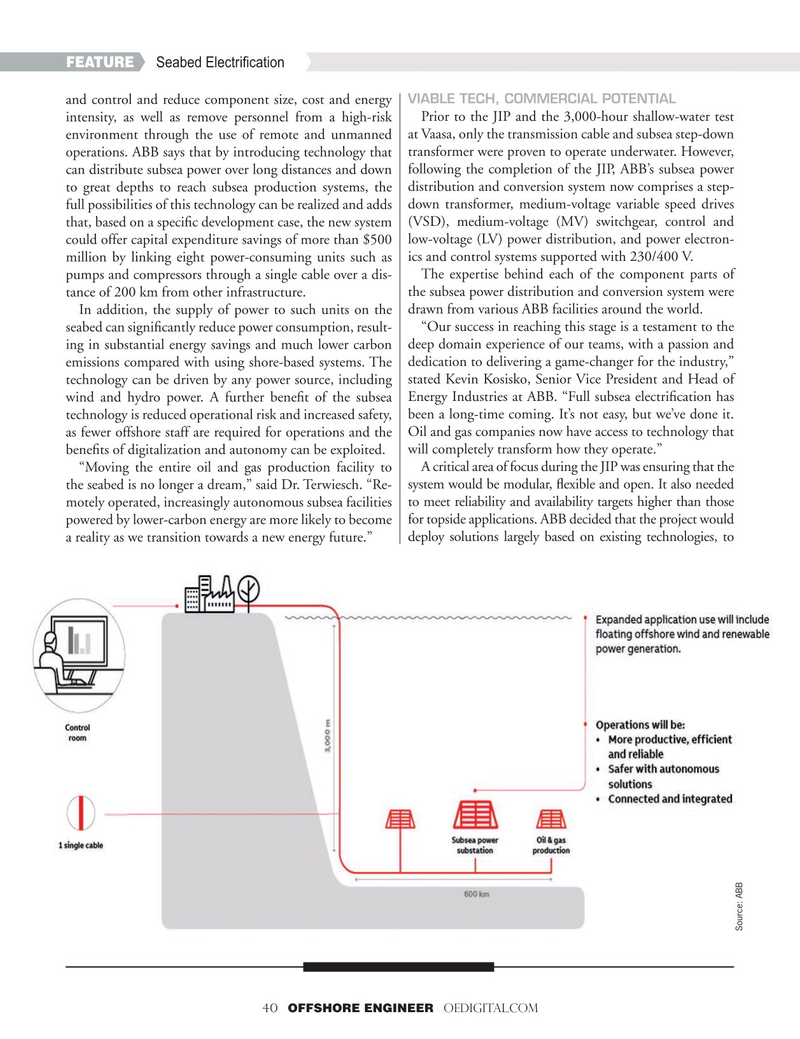
Page 40: of Offshore Engineer Magazine (Jan/Feb 2020)
Read this page in Pdf, Flash or Html5 edition of Jan/Feb 2020 Offshore Engineer Magazine
FEATURE Seabed Electri? cation
VIABLE TECH, COMMERCIAL POTENTIAL and control and reduce component size, cost and energy intensity, as well as remove personnel from a high-risk Prior to the JIP and the 3,000-hour shallow-water test environment through the use of remote and unmanned at Vaasa, only the transmission cable and subsea step-down operations. ABB says that by introducing technology that transformer were proven to operate underwater. However, can distribute subsea power over long distances and down following the completion of the JIP, ABB’s subsea power to great depths to reach subsea production systems, the distribution and conversion system now comprises a step- full possibilities of this technology can be realized and adds down transformer, medium-voltage variable speed drives that, based on a speci? c development case, the new system (VSD), medium-voltage (MV) switchgear, control and could offer capital expenditure savings of more than $500 low-voltage (LV) power distribution, and power electron- million by linking eight power-consuming units such as ics and control systems supported with 230/400 V. pumps and compressors through a single cable over a dis- The expertise behind each of the component parts of tance of 200 km from other infrastructure. the subsea power distribution and conversion system were
In addition, the supply of power to such units on the drawn from various ABB facilities around the world.
seabed can signi? cantly reduce power consumption, result- “Our success in reaching this stage is a testament to the ing in substantial energy savings and much lower carbon deep domain experience of our teams, with a passion and emissions compared with using shore-based systems. The dedication to delivering a game-changer for the industry,” technology can be driven by any power source, including stated Kevin Kosisko, Senior Vice President and Head of wind and hydro power. A further bene? t of the subsea Energy Industries at ABB. “Full subsea electri? cation has technology is reduced operational risk and increased safety, been a long-time coming. It’s not easy, but we’ve done it. as fewer offshore staff are required for operations and the Oil and gas companies now have access to technology that bene? ts of digitalization and autonomy can be exploited. will completely transform how they operate.” “Moving the entire oil and gas production facility to A critical area of focus during the JIP was ensuring that the the seabed is no longer a dream,” said Dr. Terwiesch. “Re- system would be modular, ? exible and open. It also needed motely operated, increasingly autonomous subsea facilities to meet reliability and availability targets higher than those powered by lower-carbon energy are more likely to become for topside applications. ABB decided that the project would a reality as we transition towards a new energy future.” deploy solutions largely based on existing technologies, to
Source: ABB 40 OFFSHORE ENGINEER OEDIGITAL.COM

 39
39

 41
41